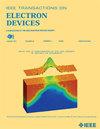High-Speed Ultraviolet Photodetector Based on p-GaN Gate HEMT for Flame Monitoring
IF 2.9
2区 工程技术
Q2 ENGINEERING, ELECTRICAL & ELECTRONIC
引用次数: 0
Abstract
The p-GaN gate high electron mobility transistor (HEMT) with a本研究设计并制作了灵敏度为$2.0\ × 10^{-{5}}$ cm2的p-GaN栅极高电子迁移率晶体管(HEMT)作为紫外光电探测器(PD)。采用氮化镓/氮化镓(GaN)的异质结构得到二维电子气(2DEG)作为导电通道,其光响应率高达8.07\ × 10^{{4}}$ a /W,截止波长为360 nm,紫外可见抑制比高达1.80\ × 10^{{4}}$,上升时间和衰减时间分别为0.12和1.0 ms。在360 nm紫外光照射下,在低紫外光强度为5 mW/cm2的条件下,测得暗电流为5.44\ × 10^{-{3}}$ A,光电流为4.42\ × 10^{{3}}$ A,外量子效率(EQE)为2.77% $\ × 10^{{5}}$ %,探测率为8.31\ × 10^{{5}}$ Jones。结果表明,与文献相比,基于AlGaN/GaN HEMT制备的UV PD的性能得到了显著提高。与现有设备相比,该设备具有更低的噪声等效功率(NEP)和增强的探测功能,是军事和空间应用的有希望的候选者。
本文章由计算机程序翻译,如有差异,请以英文原文为准。
求助全文
约1分钟内获得全文
求助全文
来源期刊

IEEE Transactions on Electron Devices
工程技术-工程:电子与电气
CiteScore
5.80
自引率
16.10%
发文量
937
审稿时长
3.8 months
期刊介绍:
IEEE Transactions on Electron Devices publishes original and significant contributions relating to the theory, modeling, design, performance and reliability of electron and ion integrated circuit devices and interconnects, involving insulators, metals, organic materials, micro-plasmas, semiconductors, quantum-effect structures, vacuum devices, and emerging materials with applications in bioelectronics, biomedical electronics, computation, communications, displays, microelectromechanics, imaging, micro-actuators, nanoelectronics, optoelectronics, photovoltaics, power ICs and micro-sensors. Tutorial and review papers on these subjects are also published and occasional special issues appear to present a collection of papers which treat particular areas in more depth and breadth.
 求助内容:
求助内容: 应助结果提醒方式:
应助结果提醒方式:


